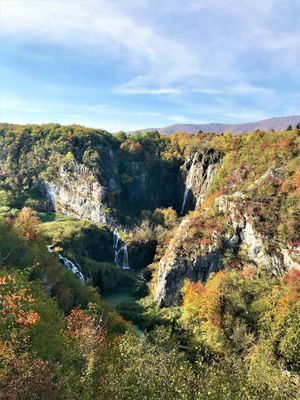Plitvice Lakes National Park - Croatia
Jump to navigation
Jump to search
>>>Back to Case Studies Overview
>>>Add here a title for your case
| Name | Plitvice Lakes National Park | |
| Place | Plitvica Selo | |
| Country | Republic of Croatia | |
| Author(s) | Vedran Vuković | |
| World Heritage | UNESCO World Heritage Site, 1979 | |
|
| ||
Why is this case relevant?
- Plitvice lakes national park is located in the Republic of Croatia and it is the Croatian oldest and largest national park, having that status since 1949. It is located in a mountainous karst region with a surface of just under 300 square kilometers in size. Primarily covered in forest vegetation with some smaller grassland areas and 16 larger and several smaller cascading lakes connected by waterfalls, which are its key feature. The unique characteristic of Plitvice lakes is the biodynamic process of sedimentary tufa rocks formation and consequentially tufa (travertine) barriers which resulted in the creation of the characteristic lakes and waterfalls. This would be the outstanding value of the location which led to its international recognition and its declaration as a UNESCO World Heritage site in 1979. On top of its geological uniqueness, Plitvice lakes is abundantly rich in flora and fauna, out of which a lot are endemic and some have been placed on the red list of protected species, with approximately 1400 plant species present and a large number of animals, including some larger predator species.
Which idea of ‘design with nature’ guides the design concept of this site?
- In this section you talk about the design concept of your area. Is it a highly maintained site, i.e. does the design with nature require intensive maintenance? Or does the site follow a more organic interpretation of nature? Which changes are expected if maintenance is missing?
Which challenges is this landscape facing?
- Here you discuss the types of negative impact you are observing but you can also mention new functions that could give a development opportunity
What would be your strategy for improvement?
Finally, please share some ideas of how you would initiate positive change for your heritage area
Image Gallery
- Yourimage.jpg
your image text and source
- Yourimage.jpg
your image text and source
- Yourimage.jpg
your image text and source
- Yourimage.jpg
your image text and source
- Yourimage.jpg
your image text and source
- Yourimage.jpg
your image text and source
- Yourimage.jpg
your image text and source
- Yourimage.jpg
your image text and source
References
- Author Year: Title, publisher, edition, page, ...
- etc.
- Website Year: Link, keyword, ...
- etc.
